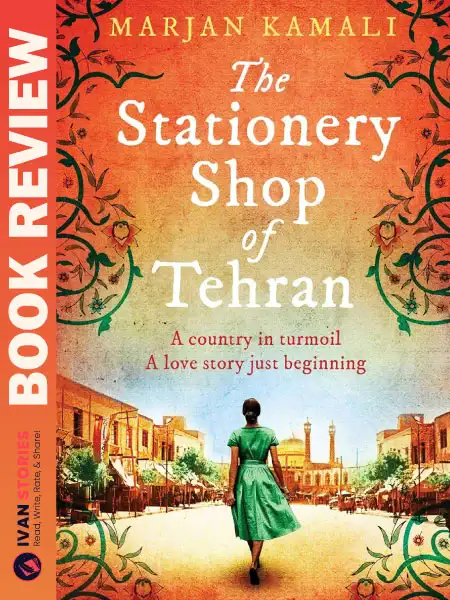Book Highlights
| Author Name | Marjan Kamali |
| Country | Turkey |
| Book Type | Fiction |
| Page Count | 320 |
| Genre | Historical Fiction, Romance |
| Story Setting | Tehran and the U.S., spanning 1953-2013 |
| What to Expect | Lost Love, Political Upheaval, Heartbreak, Fate |
| Readability | Steady-Paced, Emotional, Evocative |
Book Review
A Poignant Tale of Love and Loss
Marjan Kamali’s The Stationery Shop is a beautiful, heart-wrenching novel set against the backdrop of political upheaval in 1950s Iran. The story follows Roya, a young woman who discovers both her love of books and the man she would come to love, Bahman, in a quaint stationery shop in Tehran. Their relationship blossoms amidst the chaos of the Iranian coup d’état, a political storm that threatens not only the country but also their future together. When Bahman fails to show up for their planned wedding day, Roya is left heartbroken, with only questions in place of the promises they had made. Sixty years later, an unexpected reunion allows Roya to seek the answers that have haunted her for a lifetime.
The Stationery Shop is more than just a love story. It’s a reflection on fate, loss, and the power of unresolved emotions. The book flits between 1950s Iran and modern-day America, contrasting a young, idealistic Roya with her older self, who is still seeking closure. The novel deftly explores how political turmoil and personal tragedy intertwine, shaping the lives of its characters in irrevocable ways.
Characters Full of Depth and Complexity
Roya and Bahman’s love is the heart of the novel, but it’s their individual character arcs that keep readers engrossed. Roya begins the story as a hopeful teenager, immersed in literature and deeply drawn to Bahman’s passion for social change. Her love for Bahman is sincere and unshakable, making her heartbreak all the more poignant when he disappears without a word. Roya’s journey, from a young girl on the brink of marriage to a woman who builds a life without the love she once knew, is emotionally raw and achingly real. Even as she ages, Roya’s longing for Bahman remains, illustrating the persistence of love across time and circumstance.
Bahman, on the other hand, is complex, passionate, but ultimately shaped by forces outside of his control—his own family and the shifting political landscape of Iran. His absence from Roya’s life is both mysterious and devastating, and when he reappears decades later, his motivations reveal a depth of tragedy that explains his choices, even if they don’t heal all the wounds they caused.
Supporting characters, like Mr. Fakhri, the kindly stationery shop owner, and Roya’s husband, Walter, add layers of richness to the story. Walter, especially, stands out as a symbol of quiet, steadfast love—a contrast to the fiery, youthful passion Roya shared with Bahman.
Kamali’s Mesmerizing Writing Style
Kamali’s writing is rich with sensory detail and emotional nuance. Her descriptions of Tehran’s vibrant streets, the warmth of the stationery shop, and the scents of Persian food bring the setting to life in a way that immerses the reader fully. You can almost taste the saffron, feel the tension in the air as political unrest brews, and smell the ink of the letters exchanged between Roya and Bahman.
The novel’s pacing is steady, though at times the shifts between past and present slow the narrative slightly. However, Kamali’s ability to evoke such deep emotion makes these transitions feel necessary—like breaths between heartbeats.
One of the most remarkable aspects of The Stationery Shop is how it seamlessly intertwines personal and political stories. While at its core, it’s about love and heartbreak, the novel never loses sight of the greater forces at play—the coup, the cultural changes in Iran, and the immigrant experience in America.
Emotional Impact and Reflections
Reading The Stationery Shop feels like a slow burn, the kind of story that seeps into your bones. The heartbreak is real, palpable, and Kamali doesn’t shy away from difficult emotions. There are moments in the book that leave you feeling raw—particularly when Roya confronts Bahman after all those years. The final pages are particularly powerful, bringing both closure and lingering sadness. It’s a story that stays with you long after you close the book, leaving a lump in your throat and a bittersweet ache in your heart.
Final Thoughts: A Haunting Exploration of Love and Fate
Marjan Kamali has crafted a tender, deeply moving tale of love, fate, and the choices we make—or have made for us. The Stationery Shop is a novel that will appeal to readers who enjoy historical fiction, particularly stories with rich cultural backdrops and complex, emotional relationships. While the pacing may be slow for some, the payoff is well worth it, especially for those who appreciate a story that tugs at the heartstrings.
For fans of love stories with depth, historical context, and emotional complexity, The Stationery Shop is a must-read. Prepare for a journey that will leave you teary-eyed, contemplative, and with a deep appreciation for the power of time and fate in shaping our lives.






